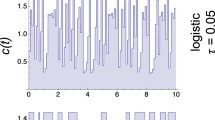Abstract
Ifconstancy is a measure of an ecosystem's (in) variability through time andstability is a measure of the system's ability to damp and recover from environmental perturbations, then constancy depends not only on stability but also on the frequency and amplitude of perturbations—theenvironmental “noise level”. The stability of an ecosystem reflects its texture, extent, and viscosity (fine-scale structure); the noise level experienced by the system (“effective” noise level) reflects the level at any point (“ambient” noise level), the spectrum of stochastic scale (regional distribution of stochasticity), and the system's spatial extent (size, or number of patches included). The coefficient of variation of a limiting stochastic variate is a measure of the effective noise level. Ifp is the total number of patches in the system (its extent) andn is the number of contiguous patches with noise signals correlated through time (its stochastic scale), then the coefficient of variation is directly proportional to\(\sqrt {(n/p)} \) whenevern<p. Thus ecosystems of small stochastic scalen or large sizep damp out environmental noise by “spreading the risk” in space, thereby reducing their variability in time.
Similar content being viewed by others
Literature
Boer, P. J. den. 1968. “Spreading of risk and stabilization of animal numbers.”Acta Biotheor.,18, 165–194.
—. 1971. “Stabilization of animal numbers and the heterogeneity of the environment: the problem of the persistence of sparse populations.” InProceedings of the Advanced Study Institute on “Dynamics of Numbers in Populations.” Boer, P. J. den and Gradwell, G. R., eds., pp. 77–97. Centre for Agricultural Publishing and Documentation. Wageningen, The Netherlands.
— and G. R. Gradwell, eds. 1971.Proceedings of the Advanced Study Institute on “Dynamics of Numbers in Populations.” Centre for Agricultural Publishing and Documentation, Wageningen, The Netherlands.
Borchert, J. R. 1950. “The climate of the central North American grassland.”Ann. Ass. Am. Geogr.,40, 1–39.
Cooper, C. F. 1961. “The ecology of fire.”Scient. Am.,204, 150–160.
Crowley, P. H. 1975. “Spatial heterogeneity and the stability of a predator-prey link.” Ph.D. Thesis, Michigan State University.
Crowley, P. H. 1975. “A graphical analysis of predator-prey dynamics: effective size and the persistence of ecosystems.” In preparation.
Holling, C. S. 1973. “Resilience and stability of ecological systems”A. Rev. Ecol. System.,4, 1–23.
Horn, H. S. and R. H. MacArthur 1972. “On competition in a diverse and patchy environment.”Ecology,53, 749–752.
Huffaker, C. B. 1958. “Experimental studies on predation: dispersion factors and predator-prey oscillations.”Hilgardia,27, 323–383.
Langmuir, I. 1938. “Surface motion of water induced by wind.”Science,87, 119–123.
Levin, S. A. and R. T. Paine. 1974. “Disturbance, patch formation, and community structure.”Proc. Natn. Acad. Sci. U.S.A.,71, 2744–2747.
Loucks, O. L. 1970. “Evolution of diversity, efficiency and community stability”Am. Zool.,10, 17–25.
Luckinbill, L. S. 1973. “Coexistence in laboratory populations ofParamecium aurelia and its predatorDidinium nasutum.”Ecology,54, 1320–1327.
— 1974. “The effects of space and enrichment on a predator-prey, system.”Ecology,55, 1142–1147.
MacArthur, R. and E. Pianka. 1966. “On optimal use of a patchy environment.”Am. Nat., 100, 603–609.
May, R. M. 1971. “Stability in model ecosystems.”Proc. Ecol. Soc. Australia,6, 18–56.
— 1973.Complexity and Stability in Model Ecosystems. Princeton, N.J.: Princeton Univ. Press.
— 1974. “Ecosystem patterns in randomly fluctuating environments.” InProgress in Theoretical Biology, Vol. 3. Rosen, R. and R. M. Snell, eds., pp. 1–50. New York: Academic Press.
Platt, T. and K. L. Denman. 1975. “Spectral analysis in ecology.”A. Rev. Ecol. System.,4, 189–210.
Powell, T. M., P. J. Richerson, T. M. Dillon, B. A. Agee, B. J. Dozier, D. A. Godden and L. O. Myrup. 1975. “Spatial scales of current speed and phytoplankton biomass fluctuations in Lake Tahoe.”Science,189, 1088–1090.
Reddingius, J. and P. J. den Boer. 1970. “Simulation experiments illustrating stabilization of animal numbers by spreading of risk.”Oecologia,5, 240–284.
Richards, P. and G. B. Williamson. 1975. “Treefalls and patterns of understory species in a wet lowland tropical forest.”Ecology,56, 1226–1229.
Roff, D. A. 1974a. “Spatial heterogeneity and the persistence of populations.”Oecologia,15, 245–258.
— 1974b. “An analysis of a population model demonstrating the importance of dispersal in a heterogeneous environment.”Oecologia,15, 259–275.
— 1974c. “A comment of the Number-of-Factors Model of Reddingius and den Boer.”Am. Nat.,108, 391–393.
Rosen, R. 1970.Dynamical System Theory in Biology, Vol. 1:Stability Theory and its Applications. New York: Wiley.
Sanders, H. L. 1969. “Benthic marine diversity and the stability-time hypothesis.” InDiversity and Stability in Ecological Systems. Woodwell, G. M. and H. H. Smith, eds. pp. 71–81. Brookhaven Symposia in Biology, Number 22. Brookhaven Natn. Lab., Upton, N.Y.
Slobodkin, L. B. and H. L. Sanders. 1969. “On the contribution of environmental predictability to species diversity.” InDiversity and Stability in Ecological Systems. Woodwell, G. M. and H. H. Smith, eds., pp. 82–95. Brookhaven Symposia in Biology, Number 22. Brookhaven Natn. Lab., Upton, N.Y.
Smith, F. E. 1972. “Spatial heterogeneity, stability and diversity in ecosystems.” InGrowth by Intussusception: Ecological Essays in Honor of G. Evelyn Hutchinson, Deevey, E. S., ed., pp. 309–335. New Haven: Conn. Acad. Arts Sci.
Author information
Authors and Affiliations
Rights and permissions
About this article
Cite this article
Crowley, P.H. Spatially distributed stochasticity and the constancy of ecosystems. Bltn Mathcal Biology 39, 157–166 (1977). https://doi.org/10.1007/BF02462855
Issue Date:
DOI: https://doi.org/10.1007/BF02462855




